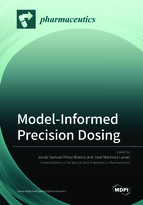Model-Informed Precision Dosing
A special issue of Pharmaceutics (ISSN 1999-4923). This special issue belongs to the section "Pharmacokinetics and Pharmacodynamics".
Deadline for manuscript submissions: closed (15 February 2022) | Viewed by 55358
Special Issue Editors
2. Institute for Biomedical Research of Salamanca (IBSAL), University Hospital of Salamanca, Hospital Virgen de la Vega, Paseo de San Vicente, 58-182, 37007 Salamanca, Spain
Interests: pharmacometrics (PMX); population pharmacokinetics (PopPK); pharmacokinetics-pharmacodynamics (PKPD); model-informed precision dosing (MIPD); modeling and simulation (M&S)
2. Institute of Biomedical Research of Salamanca (IBSAL), Salamanca, Spain
Interests: drug delivery; cell carriers; nanoparticles; pharmacokinetics; anti-infectives; pharmaceutical development
Special Issues, Collections and Topics in MDPI journals
Special Issue Information
Dear Colleagues,
Model-informed precision dosing (MIPD) is an advanced quantitative approach focusing on individualized treatment optimization. MIPD integrates mathematical models of drugs and disease combined with individual patient characteristics (e.g., genotype, anthropometric factors, organ function). MIPD has been highlighted as a useful tool for drug dosage selection in both drug development process and clinical practice. Despite the potential benefits of this methodology toward personalized medicine, its application is still limited.
This Special Issue is focused on new MIPD strategies and methodologies to optimize drug dosage (dosing algorithms, pharmacokinetic–pharmacodynamic indexes, interactive applications, nomograms, etc.) in specific populations, allowing to evaluate the potential improvement on the clinical efficacy and/or safety of the treatments.
Dr. Jonás Samuel Pérez-Blanco
Prof. Dr. José Martínez Lanao
Guest Editors
Manuscript Submission Information
Manuscripts should be submitted online at www.mdpi.com by registering and logging in to this website. Once you are registered, click here to go to the submission form. Manuscripts can be submitted until the deadline. All submissions that pass pre-check are peer-reviewed. Accepted papers will be published continuously in the journal (as soon as accepted) and will be listed together on the special issue website. Research articles, review articles as well as short communications are invited. For planned papers, a title and short abstract (about 100 words) can be sent to the Editorial Office for announcement on this website.
Submitted manuscripts should not have been published previously, nor be under consideration for publication elsewhere (except conference proceedings papers). All manuscripts are thoroughly refereed through a single-blind peer-review process. A guide for authors and other relevant information for submission of manuscripts is available on the Instructions for Authors page. Pharmaceutics is an international peer-reviewed open access monthly journal published by MDPI.
Please visit the Instructions for Authors page before submitting a manuscript. The Article Processing Charge (APC) for publication in this open access journal is 2900 CHF (Swiss Francs). Submitted papers should be well formatted and use good English. Authors may use MDPI's English editing service prior to publication or during author revisions.
Keywords
- model-informed precision dosing (MIPD)
- efficacy PKPD indexes
- pharmacokinetics
- pharmacodynamics
- PKPD modeling and simulation
- dosing algorithms
- nomograms








